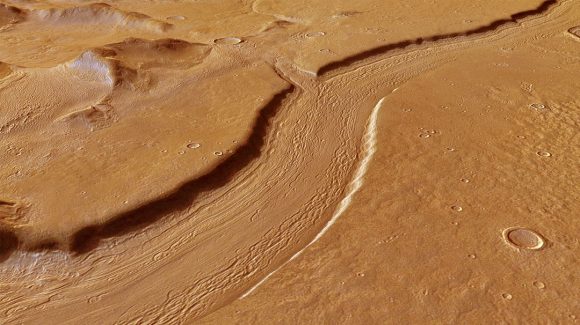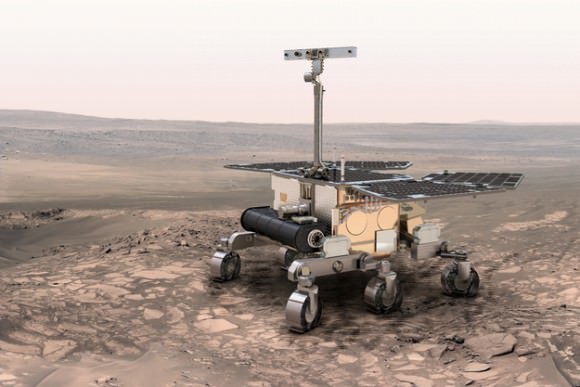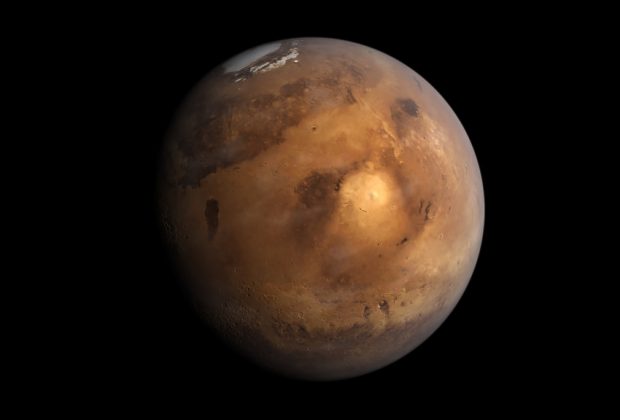Mars modern landscape is something of a paradox. It’s many surface features are very similar to those on Earth that are caused by water-borne erosion. But for the life of them, scientists cannot imagine how water could have flown on Mars’ cold and desiccated surface for most of Mars’ history. Whereas Mars was once a warmer, wetter place, it has had a very thin atmosphere for billions of years now, which makes water flow and erosion highly unlikely.
In fact, while the surface of Mars periodically becomes warm enough to allow for ice to thaw, liquid water would boil once exposed to the thin atmosphere. However, in a new study led by an international team of researchers from the UK, France and Switzerland, it has been determined that a different kind of transport process involving the sublimation of water ice could have led to the Martian landscape becoming what it is today.
The study, which was led Dr. Jan Raack – a Marie Sklodowska-Curie Research Fellow at The Open University – was recently published in the scientific journal Nature Communications. Titled “Water Induced Sediment Levitation Enhances Downslope Transport on Mars”, this research study consisted of experiments that tested how processes on Mars’ surface could allow water transport without it being in liquid form.

To conduct their experiments, the team used the Mars Simulation Chamber, an instrument at The Open University that is capable of simulating the atmospheric conditions on Mars. This involved lowering the atmospheric pressure inside the chamber to what is normal for Mars – about 7 mbar, compared to 1000 mbar (1 bar or 100 kilopascals) here on Earth – while also adjusting temperatures.
On Mars, temperatures range from a low of -143 °C (-255 °F) during winter at the poles to a high of 35 °C (95 °F) at the equator during midday in the summer. Having recreated these conditions, the team found that when water ice exposed to the simulated Martian atmosphere, it would not simply melt. Instead, it would become unstable and begin violently boiling off.
However, the team also found that this process would be capable of moving large amounts of sand and sediment, which would effectively “levitate” on the boiling water. This means that, compared to Earth, relatively small amounts of liquid water are capable of moving sediment across the surface of Mars. These levitating pockets of sand and debris would be capable of forming tje large dunes, gullies, recurring slope lineae, and other features observed on Mars.
In the past, scientists have indicated how these features were the result of sediment transportation down slopes, but were unclear as to the mechanisms behind them. As Dr. Jan Raack explained in a OUNews press release:
“Our research has discovered that this levitation effect caused by boiling water under low pressure enables the rapid transport of sand and sediment across the surface. This is a new geological phenomenon, which doesn’t happen on Earth, and could be vital to understanding similar processes on other planetary surfaces.”

Through these experiments, Dr. Raack and his colleagues were able to shed light on how conditions on Mars could allow for features that we tend to associate with flowing water here on Earth. In addition to helping to resolve a somewhat contentious debate concerning Mars’ geological history and evolution, this study is also significant when it comes to future exploration missions.
Dr. Raack acknowledges the need for more research to confirm their study’s conclusions, and indicated that the ESA’s ExoMars 2020 Rover will be well-situated to conduct it once it is deployed :
“This is a controlled laboratory experiment, however, the research shows that the effects of relatively small amounts of water on Mars in forming features on the surface may have been widely underestimated. We need to carry out more research into how water levitates on Mars, and missions such as the ESA ExoMars 2020 Rover will provide vital insight to help us better understand our closest neighbour.”
The study was co-authored by scientists from the STFC Rutherford Appleton Laboratory, the University of Bern, and the University of Nantes. The initial concept was developed by Susan J. Conway of the University of Nantes, and was funded by a grant from the Europlanet 2020 Research Infrastructure, which is part the European Union’s Horizon 2020 Research and Innovation Program.
Be sure to check out this video of Dr. Jan Raack explaining their experiment as well, courtesy of The Open University:


Dr. Jan Raack,
In April 2013, I discovered the World’s largest impact crater. If you get the chance, please view my video on YouTube.
Mars is formed from an ice planet colliding with, then passing through the centre of the Earth. As it existed, it (the core of the ice planet) wrapped itself in the outer skin of the Earth, then continued on its journey to become Mars.
Cheers Steven Jeffs.
We seem to have two separate phenomena here.
There is ‘levitation’ phenomenon where a small amount of boiling is able to fluidise a bed of powder. This seems like a possible explanation for Reaul Vallis: the whole floor was flowing like a river, and then suddenly locked solid when there was not enough flow or gas to keep things moving.
Then there is the phenomenon we see with the water in the vacuum chamber, which looks a bit like what you get with drops of water on flour: the drops get a ‘skin’ of adsorbed particles, which lets them bounce and roll. This might happen on the surface, but I cannot see a deep stream of such particles moving in this way.
Comments?
Flat Mars society, anyone?
What’s so special about this article that it should get all the Velikovskian cranks out?